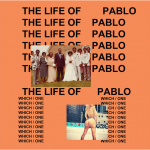Kanye West ran into a problem at the Yeezy Season 3 showcase: he couldn’t get the sound system to play his seventh studio album, which he promised to debut that evening. His fumbling with his laptop and inaudible conversation with the sound techs were displayed on Madison Square Garden’s video monitor as audience members heckled and shuffled around.
When he finally got it to work, the album reflected the essence of the odd listening party audience members paid over $100 for: highly ambitious but poorly executed.
Two days after the debut, “The Life of Pablo” was released to the public through Jay Z’s music-streaming service Tidal. For an album that has endured four name changes and nearly three years in the studio, it is a fragmented mess that flips between genres, sharing only Kanye’s signature self-centered rapping as common ground.
The album opener, “Ultralight Beam,” places Kanye in the front of a congregation preaching to the choir, a place the rest of the album reveals he does not belong in. He is later joined by Chance the Rapper, an artist known to dabble in black gospel music. Chance’s spiritual lyricism (“This little light of mine / Glory be to God”) seem to support Kanye’s claim in an interview that “The Life of Pablo” is a gospel album. However, Kanye’s reference to a “God dream” is an arrogant statement reminiscent of “I Am a God” from the rapper’s 2013 album “Yeezus,” rather than a genuine statement of spirituality.
The rest of the album, beginning with “Father Stretch My Hands Pt. 1,” assumes a thin veil of piety over hip-hop’s indulgent lifestyle – a jarring juxtaposition difficult to forget with soul samples quickly turning into Metro Boomin-produced trap beats.
“Famous” features a church organ over which Kanye raps, “For all the girls that got dick from Kanye West / If you see them in the streets give ’em Kanye’s best.”
It doesn’t stop there. “Low Lights” pairs an impassioned woman’s biblical testimony over a beat so unnervingly club-ready, it could be used by Migos. On “Feedback,” Kanye steps into the role of “ghetto Oprah” but loud-mouthedly delivers his verse in the manner of a Pentecostal revivalist delivering out “fur” and “big-booty bitches” to the masses he is preaching to. Kanye’s failure to seamlessly weave church music with club music leaves confusion as to what his vision for this album was.
But within the musical inconsistencies, the album’s strength lies in Kanye’s unapologetic lyrical honesty.
“The Life of Pablo” does not veer from Kanye’s commitment to presenting himself as his ultimate muse. He is the designer “in the fabric store picking cotton” that he raps about in “Feedback.” He genuinely pleads for “No More Parties In LA,” because it is the same city he lost his mother in. In “Wolves,” he covers his children in “lambs’ wool” to protect them from paparazzi harassment.
Even though the songs barely qualify as gospel songs, self-examination is the gospel that Kanye preaches.
Rhyming lyrics about his artistic martyrdom layered over beats he is willing to dance to in front of thousands at Madison Square Garden can only be taken seriously because Kanye believes in what he is saying and the music he is making.
“The Life of Pablo” is a mismatch of the contradictory icon Kanye embodies – a penitent sinner who cannot escape the hedonistic lifestyle of a hip-hop superstar. He hopes to find spiritual forgiveness in the atmospheric timbre of gospel choirs, but cannot help himself as he throws in a beat drop and looks for the next girl to make famous.
“What if Kanye made a song about Kanye / Called ‘I Miss the Old Kanye,’ man that would be so Kanye,” he raps on “I Love Kanye.”
In typical Kanye fashion, he went over the top and gave his audience an entire album.
– Sean Lee
